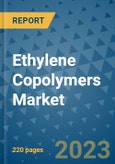The global ethylene copolymers market, valued at USD 44.3 Billion in 2021, is expected to grow at a CAGR of 3.8 percent during the forecast period. Ethylene copolymers, created by polymerizing ethylene with other molecules, such as vinyl, butyl, ethyl, and propylene, find extensive application in the automotive and packaging sectors. The market's growth is anticipated to be fueled by the rising acceptance of waste packaging recycling as an environmentally friendly practice.
Growing Consumer Awareness Drives Demand:
As consumers become more conscious of packaging waste and recycling, the demand for ethylene copolymers is expected to witness further growth. Increased research and development efforts for technological advancements and innovative product offerings by businesses are also contributing to the market expansion. Ethylene copolymers possess properties like heat resistance, chemical reactivity, formulation flexibility, cohesion, and adhesion, making them increasingly sought after in the packaging and automotive industries. The demand for ethylene copolymers is expected to rise, particularly in the food packaging sector.Shift Towards Green Energy:
The market is witnessing a shift towards renewable and biodegradable materials globally, driven by strict regulations and increased environmental consciousness. Polymers like Polyethylene Furanoate (PEF), Polyhydroxyalkanoate (PHA), and other biopolymers are replacing conventional plastics, leading to a rise in demand for ethylene copolymers. Avantium N.V. received a Horizon 2020 grant of 25 million euros ($28 million) to create a value chain for plant-based furan dicarboxylic acid and polyethylene furonoate, contributing to the growth of the market.COVID-19 Impact:
The COVID-19 pandemic has significantly affected the expansion of the ethylene copolymers industry globally, with declines in global GDP and trade volumes impacting the market. The industry is adapting to new strategies to combat the pandemic and foster future market expansion.Drivers of Growth:
Increased research and development efforts in the ethylene copolymer market have led to advancements, and economies seeking green energy solutions are driving market growth. Innovations like a new luminous ethylene-vinyl acetate (EVA) copolymer film developed in China are boosting the market. Businesses are investing in creating biodegradable products and leveraging government grants to meet the rising demand for renewable materials.Restraints:
Availability of various alternatives is posing a challenge to the expansion of the ethylene copolymers market. Governments worldwide are enforcing strict regulations for renewable and biodegradable materials, leading to a shift away from conventional plastics.Segment Overview:
The market for ethylene copolymers is segmented into thermal adhesive films, hot melt adhesives, asphalt modification, and other applications. The hot melt adhesives segment is witnessing growth due to increasing demand in the woodworking, laminating, and food packaging sectors. Ethylene copolymers offer superior bonding capabilities, environmental friendliness, and high productivity, making them preferred for hot-melt adhesives.Regional Landscape:
Asia Pacific has overtaken other regions as the leading market for ethylene copolymers, driven by increased usage in the construction of commercial buildings. The region's growing working-class population and stabilizing economy are also contributing to regional growth. Europe is witnessing expansion due to a trend towards technologically advanced structures and the use of modern materials to ensure structural integrity.Competitive Landscape:
Avantium N.V., SABIC, DuPont, Celanese Corporation, The Dow Chemical Company, BASF SE, and others are prominent players in the ethylene copolymers market.Table of Contents
1. Executive Summary
2. Market Overview
3. Production Output and Trade Statistics, 2019 - 2022
4. Price Trends Analysis and Future Projects, 2019 - 2030
5. Global Ethylene Copolymer Market Outlook, 2019 - 2030
6. North America Ethylene Copolymer Market Outlook, 2019 - 2030
7. Europe Ethylene Copolymer Market Outlook, 2019 - 2030
8. Asia Pacific Ethylene Copolymer Market Outlook, 2019 - 2030
9. Latin America Ethylene Copolymer Market Outlook, 2019 - 2030
10. Middle East & Africa Ethylene Copolymer Market Outlook, 2019 - 2030
11. Competitive Landscape
12. Appendix
Companies Mentioned
- Celanese Corporation
- BASF SE
- Exxon Mobil Corporation
- LyondellBasell Industries N.V.
- Lanxess
- SABIC
- USI Corporation
- Sipchem
- The Dow Chemical Company
- REPSOL
- Sinopec
- TotalEnergies SE
- Westlake Corporation
Methodology

LOADING...








